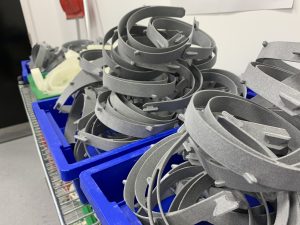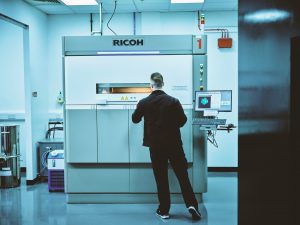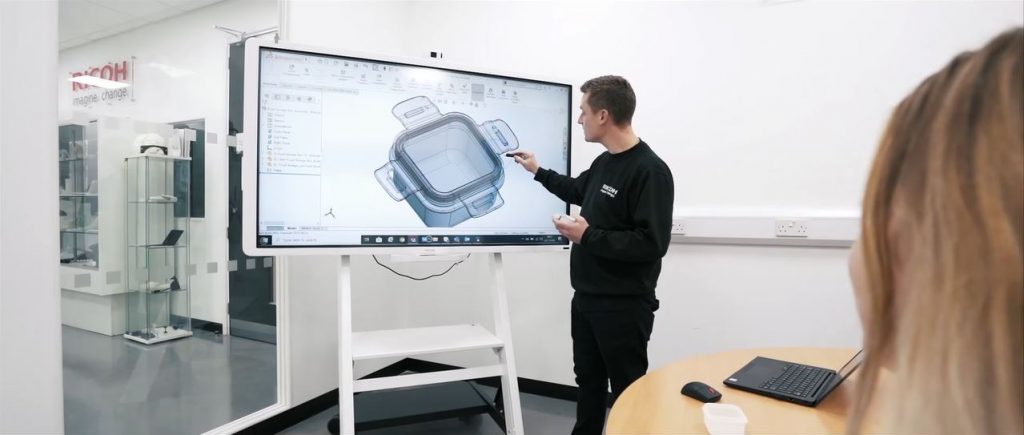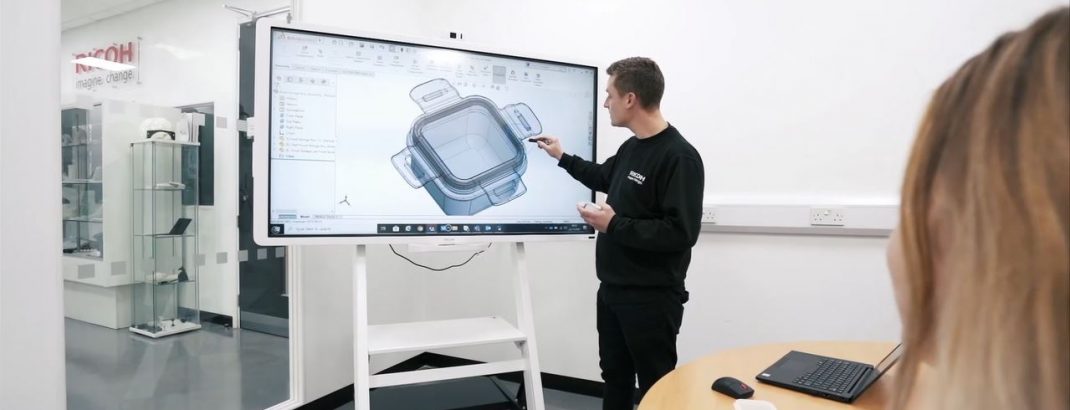Here at a crossroad for 3D printing, we reflect on a truly extraordinary year – and look ahead to a new one, writes Mark Dickin, Additive Manufacturing & Moulding Engineering Manager at Ricoh 3D.
2020 was one of the strangest – and, in many cases, hardest – years that we will live through.
One consequence of the Covid-19 crisis was that it has turbo-boosted the advancement of AM. As has often been the case throughout history, crisis inspires change.
Establishing understanding of 3D printing and its capabilities has been an ongoing part of the technology’s adoption curve, but there’s no doubt that awareness amongst the general population is now far greater as a result of the pandemic.
Whether it was producing urgent PPE supplies at a moment’s notice, printing parts for ventilators, manufacturing millions of swabs, or helping to keep businesses running when they couldn’t rely on overseas factories, AM was at the forefront as the virus first wreaked havoc. The technology literally saved lives.
At Ricoh 3D as the crisis unfolded, our team quickly sprang into action to design and 3D print a face shield solution in less than 24 hours, and within weeks had upscaled to tens of thousands of moulded parts, initially for use by frontline workers.
AM triumphed for two main reasons: the way in which the technology can be used to take a product rapidly from concept to reality, and the flexibility that 3D printing offers to switch-up production overnight.
It’s only led to prove what we as AM experts all knew! Now as we move into the new year – one where we all hope market stability will return – it’s our challenge to ensure AM can use this unexpected springboard to leap into a new era for manufacturing. Here is an overview of how we see the industry developing over the next 12 months.
Education

While some early-adopters such as aerospace and automotive are prolific users of AM many other industries have been reluctant to divert from tried and tested methods.
Crises on two fronts, Covid and climate, is forcing an urgent re-think. Filling supply gaps, remote working and local solutions are now part of the new normal in an on-demand manufacturing landscape.
The AM industry as a whole has seen steady growth for the last five years, even throughout the pandemic – and we’d anticipate that will continue to grow throughout 2021. The latest 3D Hubs report predicts an annual growth of around 24 per cent globally as more manufacturers switch on to the ability to streamline production, shorten time-to-market and save costs.
Just as notably, there has been a shift with AM being deployed increasingly for end part production, with the rapid prototyping market share falling for the first time in five years, according to Sculpteo’s latest report. AM will always have value for prototyping thanks to its ability to quickly produce multiple design iterations, but manufacturers are also now starting to really understand Design for Additive Manufacturing (DfAM) to create functional parts, many of which would be impossible using any other method. As more advanced materials enter the marketplace this year, that will increasingly be the case.
Covid-19 has also given many working from home more time to self-educate and tap into AM webinars, virtual events and online resources and we expect to see that bear fruit as the technology continues to gain momentum. Earlier in the hype curve it was once said that every home would eventually have a 3D printer, but the real power of the technology is now recognised as an industrial tool.
One of the last hurdles for widespread adoption is for AM to prove reliability and repeatability. With software and automation solutions improving at pace this is now becoming reality. As standards and accreditations also become available and align with more established technologies, we can see customer confidence grow. Ricoh 3D have signed up to a 2021 collaborative research project, the SDAM Alliance, which will help to develop new vigorous standards for 3D parts, products and materials.
It seems unlikely that we will be able to exhibit in the usual way this year, so our focus instead will be to find new ways to educate and share our expertise online.
Cost reduction

Virtually every business has been forced to look at their outgoings from top to bottom as a result of the global economic uncertainties. This has shocked many businesses out of the status quo, and into looking at innovative ways to cut costs.
AM is so often cheaper on a part-by-part basis, particularly when low to mid volumes are required as tooling costs are eliminated. With 10% of moulded production globally less than 10,000 parts, there is so much impact that 3D printing can have to drive down manufacturing costs – especially when considered at design stage when parts can be consolidated and optimised towards their intended function. But the technology makes most financial sense when all considerations are taken into account: time to market, potential supply chain disruptions, inventory and warehousing costs, and fewer defects.
Supply Chain and Localised Manufacturing

2020 was sadly the year when businesses discovered just how vulnerable their supply chains were, with many hit by factory closures and staff shortages, and those with parts from overseas suffering lengthy and costly delays.
3D printing came to the fore as a flexible technology which could step in to quickly help address shortages, whether that was otherwise unobtainable parts or repairs for factory machines, by producing parts on-demand and shipping to the customer in days rather than weeks. Last year put 3D printing in the spotlight and demonstrated its true value to customers who had never considered or dismissed it in the past. Our question is now, with customers given a new untapped route of supply – why would they now revert back?
3D printing enables some spare parts, especially for low volume or legacy products, to be stored in a digital inventory and produced at the point of need, improving after-sales service and dramatically reducing logistics and storage costs. Porsche Classic has been using 3D printing since 2018 to service the demands of their classic vehicles, which includes some 52,000 parts typically only needed in small quantities which are often completely inefficient to produce. The 3D printing process ensure absolute fidelity to the original specifications – both from a technical and visual perspective –making some of the scarcest parts much easier and more efficient to obtain and causing many other OEMs since to rethink their approach to how they store spare parts.
Our hope is that 2021 will continue to see businesses evaluating their supply chains and placing greater emphasis on localised, digital manufacturing.
Sustainability
Sustainability must be at the heart of any manufacturing strategy for the year ahead, and not just for corporations with social responsibility targets. As more and more companies build sustainability into their corporate objectives, we have seen a significant increase in the number of people asking for our environmental credentials upfront.
3D printing is the only technology which uses only the material required to manufacture the part. Material recycling and printing on-demand also helps power the movement towards a circular economy. The particular capability of 3D printing to consolidate parts into fewer, or often single, components means fewer assemblies, fewer fasteners and a simpler route to recycling.
But the inherent sustainability of AM extends much further than the print process – removing the need to store hundreds of parts and expend the energy, time and resource associated with warehousing can have significant green and financial impact. Typically, AM parts will be produced locally too and therefore do not need to be shipped thousands of miles around the world, contributing huge CO2 savings to the global effort.
Digitisation

Covid-19 has pushed fast-forward on digitisation. At Ricoh 3D, our three-year digital services strategy was accelerated and embedded over a three-month period instead in 2020, bolstered by acquisitions in IT services. Our role as a digital workplace provider has been instrumental in helping companies stay connected remotely and work smarter.
Executive Advisor for the Ricoh Institute of Sustainability and Business, Nobuo Inaba, stated in strong terms this year that 3D printing and additive manufacturing technology will “lead the world economy in the future”. With 3D printing leading the charge into Industry 4.0 we believe we will see more manufacturers in 2021 turning to service bureaus for their AM needs to minimise the risk of hardware investment. We are already seeing increased demand for services that help guide users along this journey, particularly for sectors such as medical where appetite for risk or uncertainty is low. Consultancy services can help minimise the risk of such large investments and accelerate the timeline for digitisation by taking a realistic approach to what the technology can do and sharing expertise on the right manufacturing method for each unique application.
